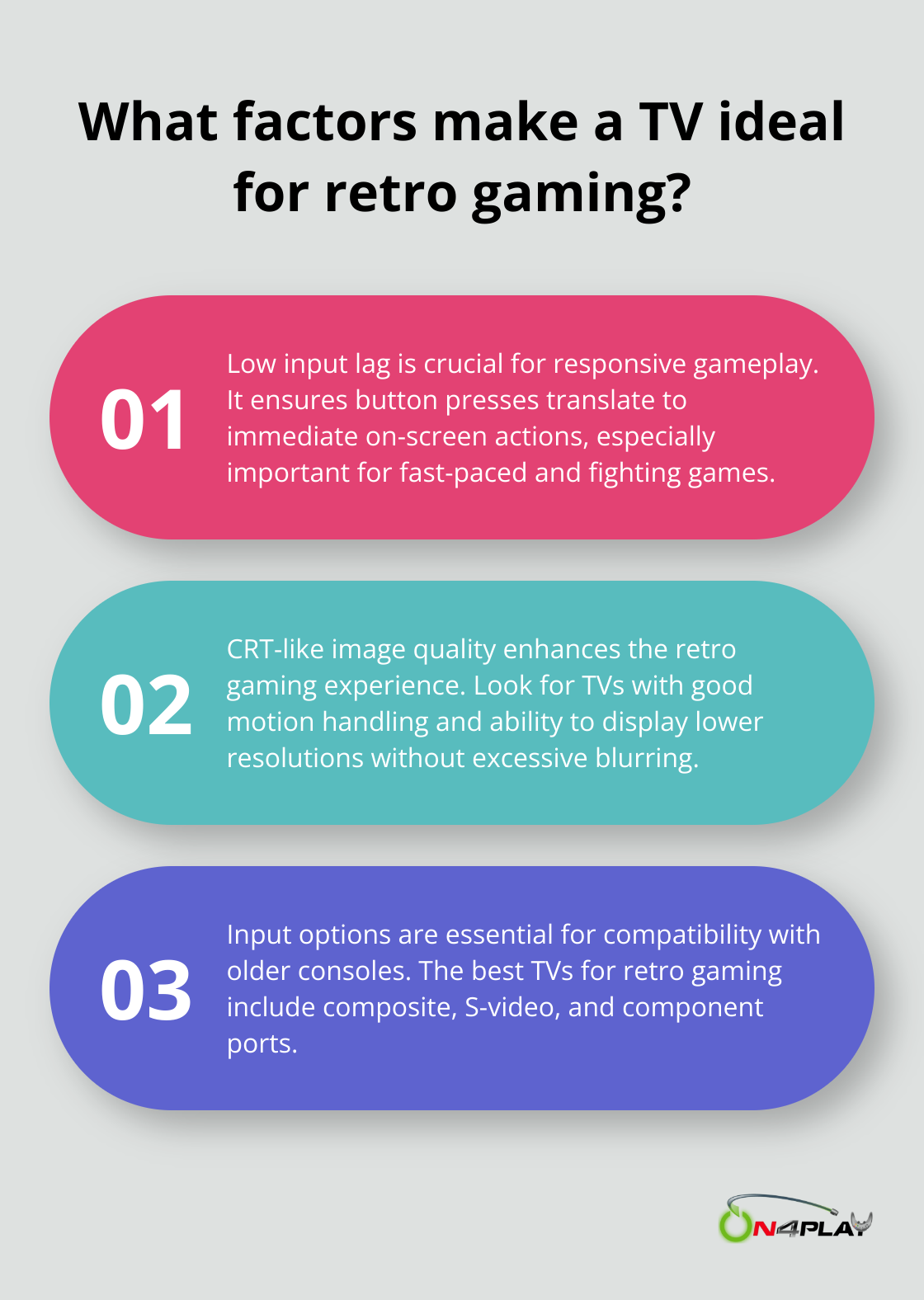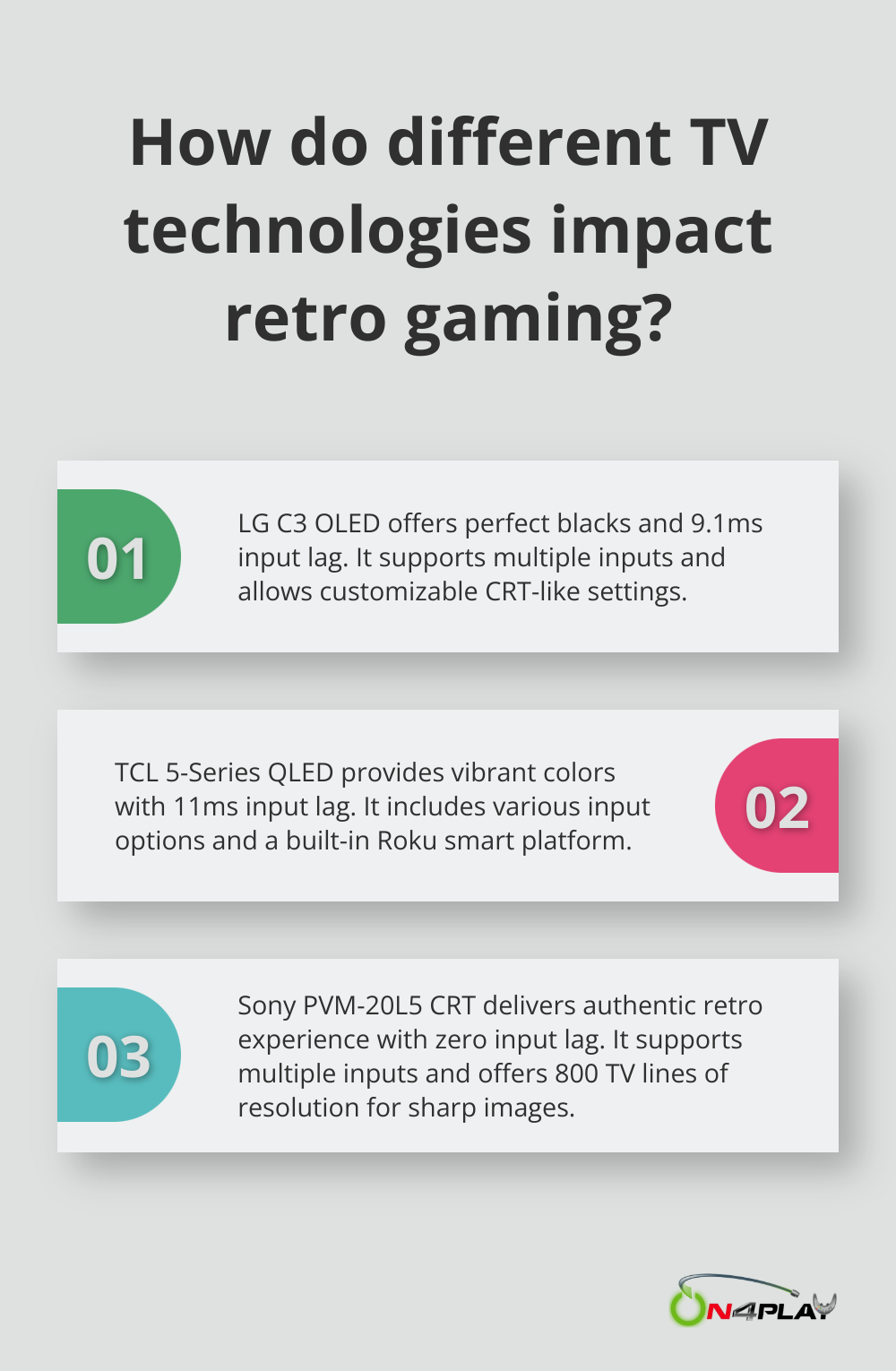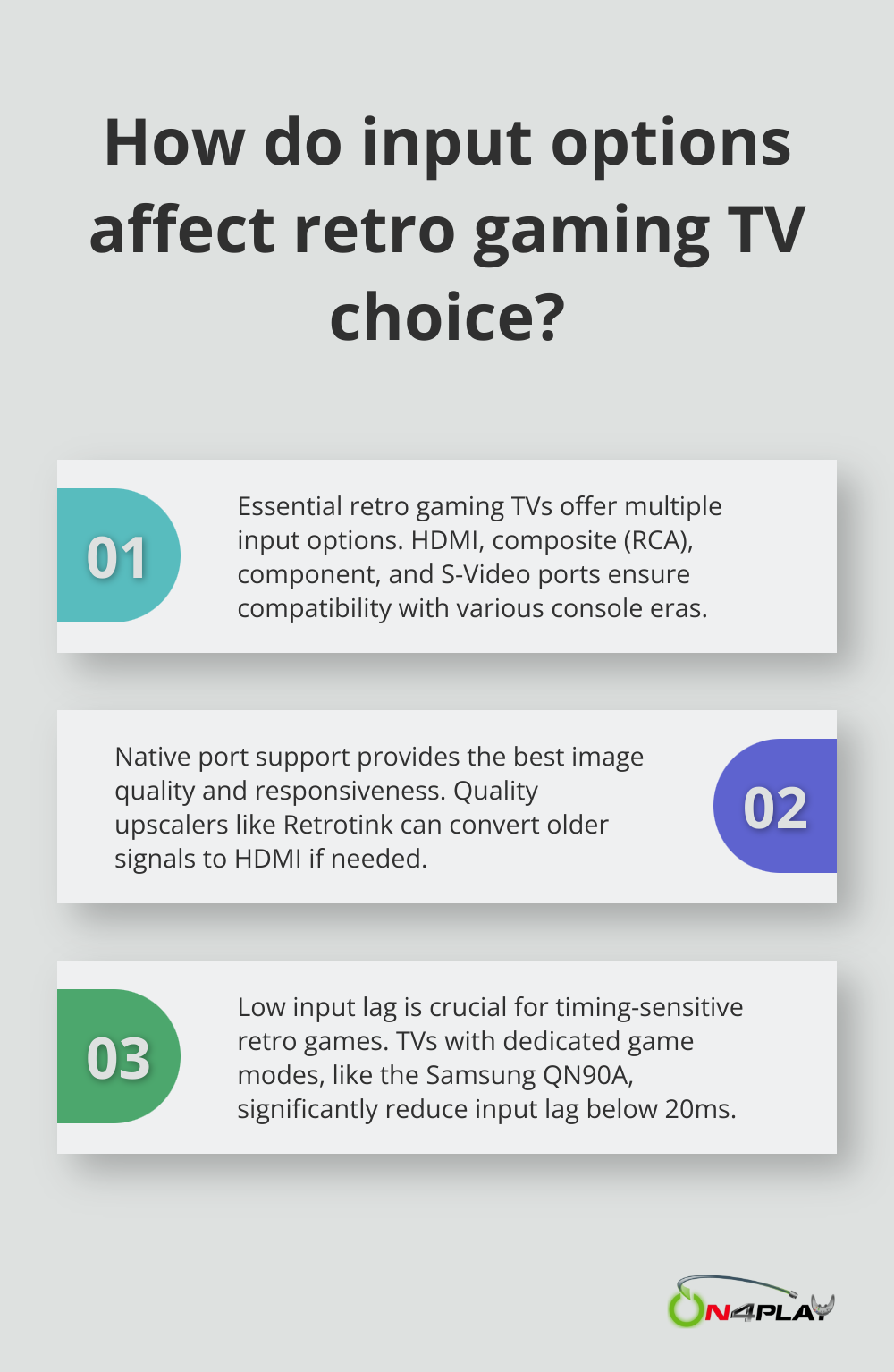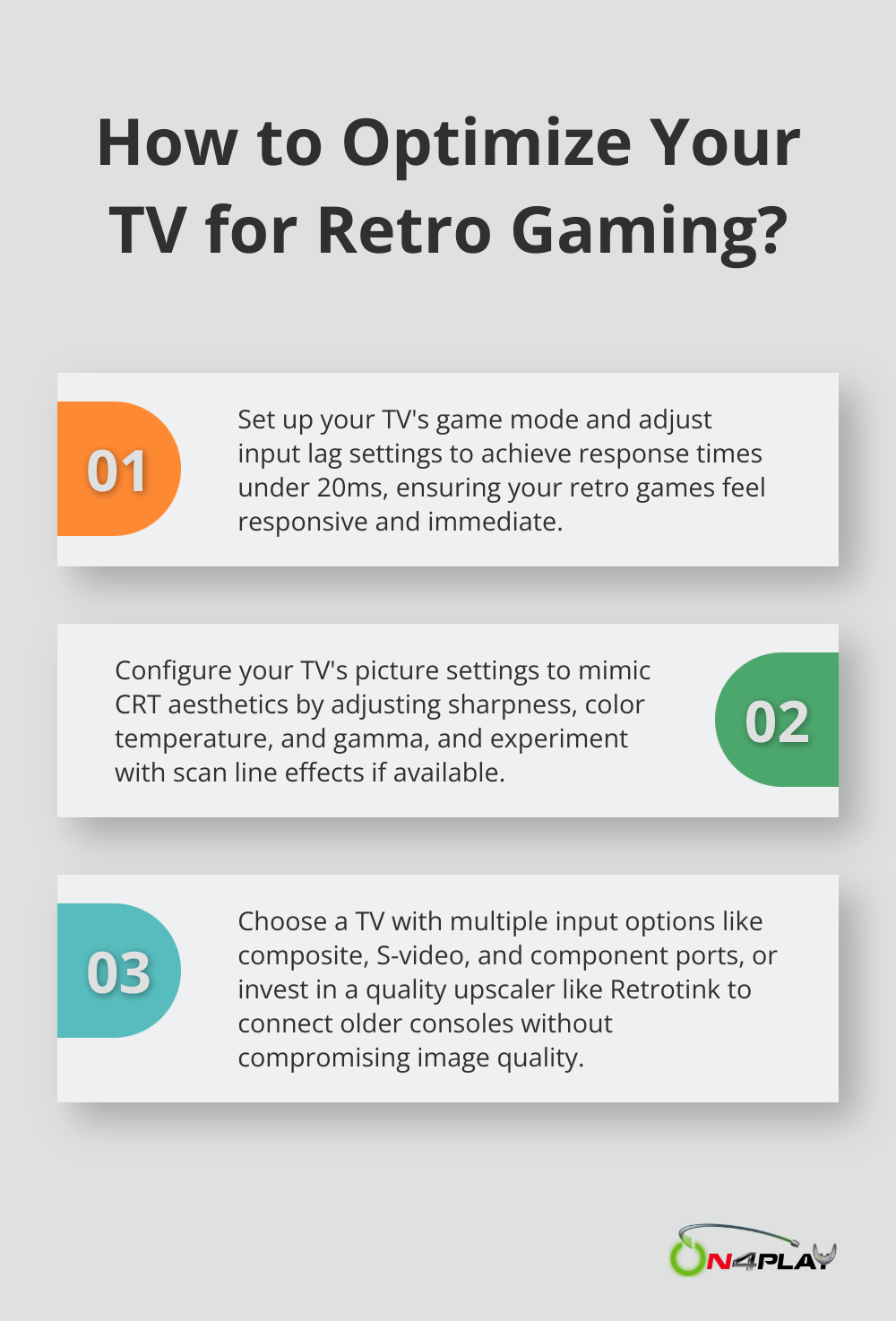At Video game reviews, we’re excited to explore the best TVs for retro gaming in 2024. The nostalgia of classic games is timeless, but finding the right display can be challenging.
We’ve researched and tested various options to help you choose the perfect TV for your retro gaming setup. Our guide covers everything from budget-friendly choices to high-end displays that capture the authentic feel of vintage gaming.
What Makes a TV Great for Retro Gaming?
Low Input Lag: The Key to Responsive Gameplay
Low input lag stands out as a primary factor for an excellent retro gaming TV. Many computer games, both modern and historical, focus on action. Success in these games relies on hand-eye coordination and fast reaction time. TVs with low input lag provide the most responsive experience, ensuring your button presses translate to immediate on-screen actions. This responsiveness is particularly important for fast-paced games and fighting titles where split-second timing is essential.
CRT-like Image Quality
Many retro games were designed with CRT displays in mind. On CRT displays, old graphics look more detailed as your brain fills in the blurred gaps. Modern TVs that can replicate this look enhance the gaming experience significantly. Look for TVs with good motion handling and the ability to display lower resolutions without excessive blurring or artifacts. Some high-end TVs offer specific modes or settings to mimic CRT aesthetics (such as scan lines or phosphor effects).
Input Options: Compatibility is King
Compatibility with older consoles is non-negotiable for a great retro gaming TV. While many modern TVs focus solely on HDMI, the best options for retro gaming include:
- Composite inputs
- S-video connections
- Component ports
If your chosen TV lacks these ports, you’ll need to invest in a quality upscaler or converter. However, native support always provides the best results.
Customizable Picture Settings
Advanced picture settings allow you to fine-tune the image to your liking. The best TVs for retro gaming offer:
- Adjustable gamma
- Color temperature controls
- Sharpness settings
Some gamers prefer a slightly softer image to mimic CRT phosphor blur, while others opt for a crisper look. The ability to customize these aspects ensures you can achieve your ideal retro aesthetic.
Screen Size Considerations
When it comes to retro gaming, bigger isn’t always better. Many classic games were designed for smaller displays, and stretching them across a massive screen can highlight imperfections. A 32-inch to 55-inch TV often provides the best balance between immersion and image quality for retro content.

Higher-end TVs typically feature superior processors that handle retro resolutions and aspect ratios more effectively. This processing power can make a significant difference in how well your classic games look on a modern display.
As we move into our top TV recommendations for retro gaming, keep these factors in mind. The best TV for you will depend on your specific needs, budget, and the types of retro games you enjoy most.
Top TVs for Retro Gaming in 2024
At Video game reviews, we tested numerous TVs to find the best options for retro gaming in 2024. Our top picks balance performance, features, and price to deliver an exceptional classic gaming experience.
LG C3 OLED: The Ultimate Retro Gaming Display
The LG C3 OLED emerges as our top choice for retro gaming enthusiasts. Its OLED technology provides perfect blacks and infinite contrast, essential for recreating the look of classic CRT displays. With an input lag of just 9.1ms in game mode, it responds incredibly fast, ensuring your inputs appear on-screen almost instantly.

The C3 supports multiple input types, including HDMI 2.1 (great for modern consoles), but also includes legacy ports for older systems. Its 4K resolution and excellent upscaling capabilities make even low-resolution retro games look sharp and clear.
One standout feature is the C3’s customizable picture settings. You can adjust the image to closely mimic the look of a CRT, including options for scan lines and phosphor effects. This level of customization appeals to purists who want an authentic retro experience.
TCL 5-Series QLED: Budget-Friendly Retro Gaming
For gamers on a tighter budget, the TCL 5-Series QLED offers impressive performance at a fraction of the cost of high-end models. While it doesn’t match the C3’s perfect blacks, its QLED technology provides vibrant colors and good contrast, enhancing the visual appeal of retro games.
The 5-Series boasts a respectable input lag of around 11ms in game mode, which suffices for most retro titles. It also includes a variety of input options, making it easy to connect older consoles without additional adapters.
The TCL shines with its built-in Roku smart platform. This allows easy access to retro-inspired indie games and streaming services that offer classic game content, adding value beyond just console gaming.
Sony PVM-20L5: The Authentic CRT Experience
For the ultimate in retro authenticity, nothing beats a genuine CRT monitor like the Sony PVM-20L5. While no longer in production, serious retro gamers highly seek these professional-grade monitors for their unparalleled image quality and zero input lag.
The PVM-20L5 supports multiple input types, including RGB (ideal for getting the best possible picture from retro consoles). Its 800 TV lines of resolution ensure sharp, clear images for both 240p and 480i content, the standard for most classic gaming systems.
However, it’s important to note that CRTs like the PVM-20L5 become increasingly rare and expensive. They also require more maintenance than modern displays and consume more power. But for those seeking the most authentic retro gaming experience possible, a high-quality CRT remains unbeatable.
These options cater to different needs and budgets, but they all excel at bringing classic games to life. In the next section, we’ll explore the key features you should look for when choosing a TV for retro gaming (regardless of your budget or preferred gaming era).
Essential Features for Retro Gaming TVs
Input Versatility
A top-notch retro gaming TV must offer a wide array of input options. While HDMI is standard for modern devices, older consoles require different connections. TVs that include composite (RCA) inputs, component inputs, and S-Video ports ensure compatibility with consoles from various eras without the need for external converters.

If your chosen TV lacks these ports, invest in a quality upscaler. The Retrotink line of products can convert older signals to HDMI while maintaining low input lag. However, native support always provides the best results in terms of both image quality and responsiveness.
Low Input Lag Performance
Input lag can make or break your gaming experience, especially with timing-sensitive retro games. TVs with a dedicated game mode significantly reduce input lag. The Samsung QN90A features VRR via FreeSync Premium, ensuring little to no screen tearing and excellent HDR performance for gaming.
To put this in perspective, the average human reaction time is about 250ms. A TV with input lag under 20ms ensures that any delay between your button press and on-screen action is imperceptible, maintaining the tight controls necessary for many classic games.
Customizable Picture Settings
The ability to fine-tune your TV’s picture is invaluable for retro gaming. Models that offer extensive picture customization options provide the best experience. Key settings to look out for include:
- Sharpness control: Allows you to soften the image to mimic CRT blur or sharpen it for a crisper look.
- Color temperature adjustments: Helps recreate the warm tones of old CRT displays or the cooler hues of early LCD screens.
- Gamma settings: Critical for ensuring proper visibility in dark game scenes.
- Aspect ratio controls: Essential for maintaining the correct proportions of 4:3 games on widescreen displays.
Some TVs (like the Sony A90J) even offer specific retro gaming picture presets that automatically adjust these settings for an authentic look.
Screen Size and Resolution
When it comes to retro gaming, bigger isn’t always better. Many classic games were designed for smaller displays, and stretching them across a massive screen can highlight imperfections. A 32-inch to 55-inch TV often provides the best balance between immersion and image quality for retro content.
Higher-end TVs typically feature superior processors that handle retro resolutions and aspect ratios more effectively. This processing power can make a significant difference in how well your classic games look on a modern display.
Audio Options
While not as critical as visual features, audio options can enhance your retro gaming experience. Try to find TVs with customizable audio settings (such as equalizers or sound modes) that can recreate the tinny speakers of old CRT TVs or enhance the audio for a more modern feel.
Final Thoughts
The best TV for retro gaming in 2024 depends on your specific needs and budget. We at Video game reviews recommend the LG C3 OLED for its perfect blacks and customizable settings, while the TCL 5-Series QLED offers great value for budget-conscious gamers. The Sony PVM-20L5 CRT monitor provides the most authentic experience for purists, despite its rarity and higher cost.

When selecting a TV, consider input options, lag performance, picture customization, and screen size. The right display will faithfully reproduce classic games’ look and feel while leveraging modern technology. We encourage you to enhance your retro gaming setup with a suitable TV that transports you back to gaming’s golden age.
For more insights on retro gaming and classic arcade experiences, explore our comprehensive reviews and guides at Video game reviews. As display technology advances, we anticipate even better ways to enjoy timeless titles in the future.





